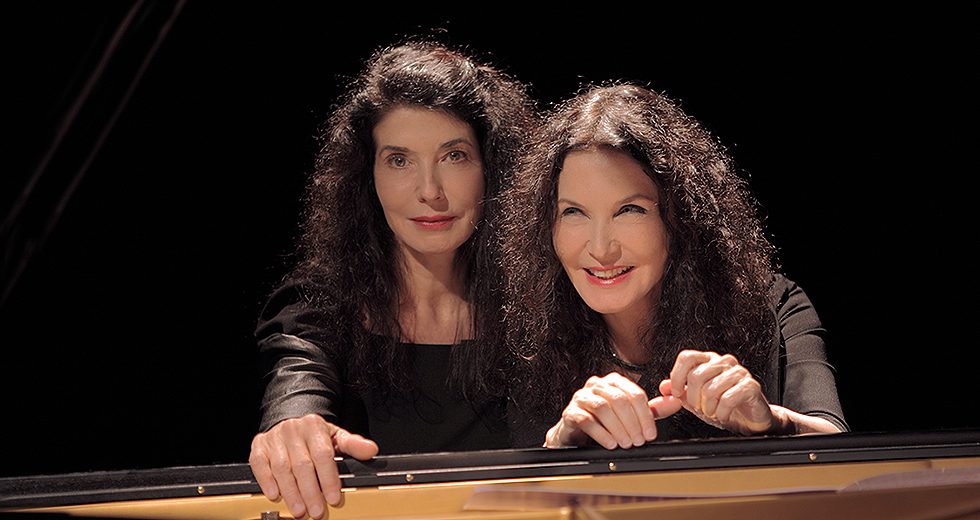
The Labèque sisters — Katia and Marielle — just might be the world’s most famous piano duo, but they are hardly resting on their laurels. Their latest recording, “Moondog Minimalist Dream House, is set for release this spring on Deutsche Grammophon, and they are scheduled to premiere new concertos for two pianos by Bryce Dessner in April and by Nico Muhly in 2019. “We still have so much to learn, to work (on), to practice. We never stop,” said Katia Labèque, calling from the Basque region of France near the Spanish border, where she and Marielle were born. “We still have tons of projects, [tons] of new music to learn. We never feel like we have arrived.”
Chicago audiences will have a chance to hear the two sisters in action May 3-5, when they join guest conductor Semyon Bychkov and the Chicago Symphony Orchestra in Max Bruch’s Concerto for Two Pianos. Though Bychkov and Marielle Labèque have been married for more than 30 years, “we play rarely together, because we have our own thing, and he has his own thing,” Katia said. “We only play together when the people really insist that we play together and then, of course, we are happy to play together. But we would never impose.”
When the three do have the chance to be onstage together, it is something “very, very special” for them. “We give a lot of attention and a lot of care to those concerts,” she said.
Given the sisters’ fame, it comes as a surprise that they did not set out to perform together. “We started as soloists,” Katia said. “We were never supposed to be a piano duet.” Their Italian mother, who was their first piano teacher, had wanted the sisters, born two years apart, to be a duo and tried to put them together when they were as young as 6 or 8 years old. “And it was a real disaster, because we had only one piano and we could not share it,” said Katia, describing the tussles that resulted.
Before they both graduated from the Paris Conservatory in 1968, they decided to pursue a career as duo pianists. The two knew nothing about the repertoire, but they had a strong desire to be together. “That was really the strongest thing,” Katia said, “because we said, ‘Now, we’re going to separate and each of us is going to go on our own path in finding concerts, and that would be very sad. It’s a lonely life on the road by yourself.’ At this moment, we said, ‘Why don’t we give it a try?’ ”
They each won coveted first prizes at the conservatory, and that worked in their favor. “Of course,” Katia said, “that attracted some visibility, and a lot of people wanted to know about the two sisters.”
A fellow student, who won first prize at the Olivier Messiaen competition in Royan in 1967, recommended that the two study the composer’s Visions de l’Amen (Visions of the Amen), a suite of seven pieces for two pianos. The Labèques liked the idea and began working on the piece. One day when they practicing, Messiaen happened to hear the sisters and asked them to play the work for him. He was so impressed that he helped them record the work for an album released in 1969.
“And that’s really how it started,” Katia said.
Through Messiaen, the sisters met Italian composer Luciano Berio, and he in turn introduced them to French composer-conductor Pierre Boulez. “We started, in fact, playing a lot of contemporary music, and it was good,” Katia said. Over time, they have worked with composers such as Thomas Adès, Osvaldo Golijov and György Ligeti. In May 2015, they presented the world premiere of Philip Glass’ Concerto for Two Pianos with conductor Gustavo Dudamel and the Los Angeles Philharmonic.
With the CSO, as noted earlier, the sisters will perform Bruch’s Concerto for Two Pianos and Orchestra, Op. 88a, written in 1912. “It’s one of the rare Romantic concertos that we [duo pianists] have in our repertoire,” Katia said. “We don’t have that many. We have Mozart, Mendelssohn and then we jump to Bartok, to Berio, to Poulenc and all the new concertos like Philip Glass.”
While none of the duo piano concertos are as famous as the leading ones for solo violin or piano, the Bruch has remained particularly under-recognized in part because of its unusual history. Bruch wrote the piece for the American duo-pianist sisters Rose and Ottilie Sutro (borrowing elements from his planned Suite No. 3 for Organ and Orchestra) and ceded sole performing rights to them. But the concerto is “tremendously difficult,” according to Katia, and the Sutros reworked it to fit their technical abilities, performing this revised version with the Philadelphia Orchestra in 1916. They made further changes a year later and performed it for a second and final time.
After Ottilie Sutro died in 1970 at age 98, some of her music-related possessions were sold at auction. Pianist Nathan Twining bought a box of unidentified papers for $11, and in it he discovered the autograph score for the sisters’ version of the concerto — a work that was all but unknown at that time. He managed to find other people at the auction and bought the orchestral parts for the first version of the piece that were in some of the other boxes. With those elements in hand, he and pianist Martin Berkofsky reconstructed Bruch’s original concerto and recorded it in 1973 with the London Symphony Orchestra.
The Labèques first performed it in the 1980s and made a recording in 1990 with London’s Philharmonic Orchestra. They have championed the concerto since, including European tour performances in February with the Royal Concertgebouw Orchestra. They consider the concerto, Katia said, “one of the major works of Bruch.”
TOP: The Labèques will perform Bruch’s Concerto for Two Pianos in concerts May 3-5 with the CSO. | Photo: Umberto Nicoletti